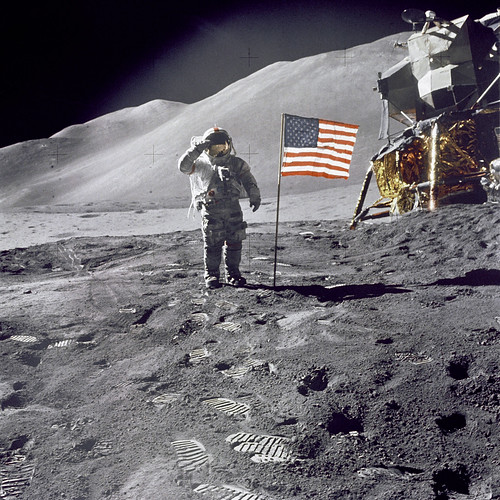7.15.2008
Moon Rocket 2.0 Flap Polarizes NASA
>


According to NASA, U.S. astronauts are scheduled to return to the moon in the year 2020, if all goes well, 48 years after the last visit in 1972.
Those in pre-school at the time, if you were even born yet, will be technically senior citizens according to AARP by the time this happens. Amazing.
In contrast, the gap between the Wright Brothers' first ever powered flight and Werner von Braun's V2 rocket (the father of the Atlas and grandfather of the Saturn V) was only 36.5 years.
The Ares rocket is slated to replace the almost useless Space Shuttle and once again provide necessary lift for longer missions.
However, a group of 57 maverick engineers (including some NASA staffers) have dreamed up a competing rocket, the Jupiter, that is purportedly far more efficient than the authorized Ares' design, which is being designed by a cast of thousands through the existing contractor system.
Why not create some competition? NASA should offer a cash prize (in the tens of millions, including personal awards) to whichever team demonstrates the working prototype faster. Contracts for future missions would be linked, pari-passu to degree of success in the endeavor. Thus, a measure of 'equity' is created for financial backers *such as contractors* to take a risk - otherwise, the effort is no more efficient than building a pyramid over the course of decades with nothing but copper chisels, wooden rollers, and the effort of thousands of Nile flood-idled farm laborers. Actually this insults the pyramid builders who built pyramids still around after 5,000 years with their bare hands, while the erstwhile rocket builders, with booku ongoing government funding and processing power 1000x more powerful than the late 60's/early 70's, have accomplished nothing in the manned spaceflight category.
Sure, the first few shuttle flights were interesting (along with the song by Rush) but by 1986 the project had reached apogee. Should have created a Saturn V successor while the top gun teams that built it were still around or available in retirement, instead of running a lame duck program for another 22 years. Now, it's like learning to ride a bicycle for the first time. It's not really resources - I read somewhere that the time-adjusted budget of NASA in 2006 was 80-85% of what it was in 1968 in its year of biggest spending. Tens of Billions of dollars are spent every year, but the only consistent return over the past two decades is knowledge gained from smaller scientific projects that typically cost a few hundred million.
After all, it's only about the future of humanity and is probably the most important achievement that could be delivered; but don't take our word for it, just google Stephen Hawking and see what you find. With this alternative management structure, let's see if it takes 48 years to reach the next milestone.
Labels: ares, hawking, jupiter, rocket, V2, vonbraun, wright

